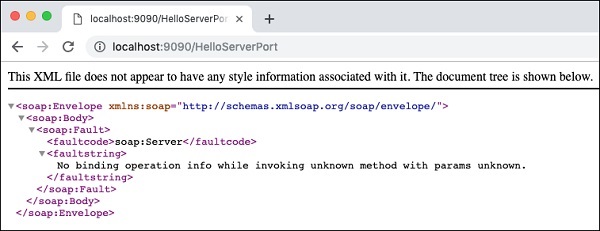
Apache CXF With POJO
Apache CXF with JAX-WS
Apache CXF with WSDL First
Apache CXF With JAX-RS
Apache CXF With JMS
Apache CXF Conclusion
Apache CXF Useful Resources
Apache CXF - Creating JAX-WS Server
We're creating a maven project using Eclipse. Go to New > Maven Project. Check the Create a simple project option. and choose the following properties −
groupid − com.tutorialspoint
artifactId − cxf-pojo
version − 1.0
After the completion of the wizard, you will find the appropriate folder structure created in your current folder along with pom.xml file.
You will add the CXF dependencies in the pom.xml. For your ready reference, we have given below the pom.xml file for the project that we created on our machine.
<?xml version = "1.0" encoding = "UTF-8"?>
<project xmlns = "http://maven.apache.org/POM/4.0.0" xmlns:xsi = "http://www.w3.org/2001/XMLSchema-instance" xsi:schemaLocation = "http://maven.apache.org/POM/4.0.0 http://maven.apache.org/xsd/maven-4.0.0.xsd">
<modelVersion>4.0.0</modelVersion>
<groupId>com.tutorialspoint</groupId>
<artifactId>cxf-pojo</artifactId>
<version>1.0</version>
<packaging>jar</packaging>
<properties>
<project.build.sourceEncoding>UTF-8</project.build.sourceEncoding>
<maven.compiler.source>24</maven.compiler.source>
<maven.compiler.target>24</maven.compiler.target>
<cxf.rt.version>4.1.3</cxf.rt.version>
</properties>
<profiles>
<profile>
<id>server</id>
<build>
<defaultGoal>test</defaultGoal>
<plugins>
<plugin>
<groupId>org.codehaus.mojo</groupId>
<artifactId>exec-maven-plugin</artifactId>
<version>1.6.0</version>
<executions>
<execution>
<phase>test</phase>
<goals>
<goal>java</goal>
</goals>
<configuration>
<mainClass>
com.tutorialspoint.cxf.jaxws.helloworld.Server
</mainClass>
</configuration>
</execution>
</executions>
</plugin>
</plugins>
</build>
</profile>
</profiles>
<dependencies>
<dependency>
<groupId>org.apache.cxf</groupId>
<artifactId>cxf-rt-features-logging</artifactId>
<version>${cxf.rt.version}</version>
<scope>test</scope>
</dependency>
<dependency>
<groupId>org.apache.cxf</groupId>
<artifactId>cxf-rt-frontend-simple</artifactId>
<version>${cxf.rt.version}</version>
</dependency>
<dependency>
<groupId>org.apache.cxf</groupId>
<artifactId>cxf-rt-transports-http</artifactId>
<version>${cxf.rt.version}</version>
</dependency>
<dependency>
<groupId>org.apache.cxf</groupId>
<artifactId>cxf-rt-frontend-jaxws</artifactId>
<version>${cxf.rt.version}</version>
</dependency>
<!-- Jetty is needed if you're using the CXFServlet -->
<dependency>
<groupId>org.apache.cxf</groupId>
<artifactId>cxf-rt-transports-http-jetty</artifactId>
<version>${cxf.rt.version}</version>
</dependency>
</dependencies>
</project>
HelloWorld.java
package com.tutorialspoint.cxf.jaxws.helloworld;
import jakarta.jws.WebService;
@WebService
public interface HelloWorld {
String greetings(String text);
}
HelloWorldImpl.java
package com.tutorialspoint.cxf.jaxws.helloworld;
public class HelloWorldImpl implements HelloWorld {
@Override
public String greetings(String name) {
return ("hi " + name);
}
}
Server.java
package com.tutorialspoint.cxf.jaxws.helloworld;
import org.apache.cxf.feature.LoggingFeature;
import jakarta.xml.ws.Endpoint;
public class Server {
public static void main(String[] args) throws Exception {
HelloWorld implementor = new HelloWorldImpl();
Endpoint.publish("http://localhost:9090/HelloServerPort",
implementor,
new LoggingFeature());
System.out.println("Server ready...");
Thread.sleep(5 * 60 * 1000);
System.out.println("Server exiting ...");
System.exit(0);
}
}
WEB-INF/web.xml
<?xml version = "1.0" encoding = "UTF-8"??>
<web-app xmlns = "http://java.sun.com/xml/ns/javaee"
xmlns:xsi="http://www.w3.org/2001/XMLSchema-instance" version="2.5"
xsi:schemaLocation = "http://java.sun.com/xml/ns/javaee
http://java.sun.com/xml/ns/javaee/web-app_2_5.xsd">
<display-name>cxf</display-name>
<servlet>
<description>Apache CXF Endpoint</description>
<display-name>cxf</display-name>
<servlet-name>cxf</servlet-name>
<servlet-class>
org.apache.cxf.transport.servlet.CXFServlet
</servlet-class>
<load-on-startup>
1
</load-on-startup>
</servlet>
<servlet-mapping>
<servlet-name>
cxf
</servlet-name>
<url-pattern>
/services/*
</url-pattern>
</servlet-mapping>
<session-config>
<session-timeout>60</session-timeout>
</session-config>
</web-app>
WEB-INF/cxf-servlet.xml
<beans xmlns="http://www.springframework.org/schema/beans"
xmlns:xsi="http://www.w3.org/2001/XMLSchema-instance"
xmlns:jaxws="http://cxf.apache.org/jaxws"
xsi:schemaLocation="http://www.springframework.org/schema/beans
http://www.springframework.org/schema/beans/spring-beans-2.0.xsd
http://cxf.apache.org/jaxws
http://cxf.apache.org/schemas/jaxws.xsd">
<jaxws:endpoint xmlns:helloworld = "https://www.tutorialspoint.com/"
id = "helloHTTP"
address = "http://localhost:9090/HelloServerPort"
serviceName = "helloworld:HelloServiceService"
endpointName = "helloworld:HelloServicePort">
</jaxws:endpoint>
</beans>
Running the HelloWorld Service
Now, you are ready to run the web app. In the command window, run the build script using the following command.
mvn clean install
mvn -Pserver
You will see the following message on the console −
INFO: Setting the server's publish address to be http://localhost:9090/HelloServerPort Server ready
Like earlier, you can test the server by opening the server URL in your browser.

As we did not specify any operation, only a fault message is returned to the browser by our application.
Now, try adding the ?wsdl to your URL and you will see the following output −

So our server application is running as expected. You may use the SOAP Client such as Postman described earlier to further test your service.